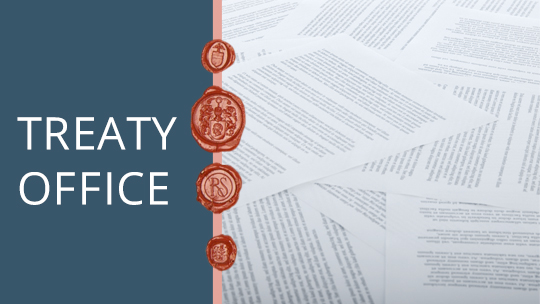About Treaties
About Conventions in the Council of Europe Treaty Series (CETS)
The Statute of the Council of Europe, signed in London on 5 May 1949, after declaring the aim of the Organisation, states in Article 1, paragraph b:
This aim shall be pursued through the organs of the Council by discussion of questions of common concern and by agreements and common action in economic, social, cultural, scientific, legal and administrative matters and in the maintenance and further realisation of human rights and fundamental freedoms.
The Council of Europe Treaty Series groups together all the conventions concluded within the Organisation since 1949. Whatever they are called ("agreement", "convention", "arrangement", "charter", "code", etc.), all these texts are international treaties in the sense of the Convention of Vienna of 1969 on the law of treaties.
The conventions of the Council of Europe are prepared and negotiated within the institutional framework of the Council of Europe. Negotiations culminate in a decision of the Committee of Ministers to adopt the final text of the proposed treaty. It is then agreed to open the treaty for signature by member States of the Council and, if necessary, by the other States or organisations who have taken part in its elaboration.
The conventions of the Council of Europe are not statutory acts of the Organisation. They owe their legal existence to the consent of those member States that sign and ratify them.
Furthermore, the great majority of the conventions of the Council of Europe make provision for non-member States of the Organisation to become Parties thereto, upon invitation by the Committee of the Ministers of the Council of Europe and by means of the procedure of accession.
The Secretary General is the depositary of the conventions of the Council of Europe. He is the custodian of these conventions and presides over their signature and the deposit of the instruments of ratification, acceptance, approval or accession. It is also the Secretary General who is responsible for the notifications prescribed in the final clauses of the conventions, and who arranges for their registration with the Secretariat of the United Nations.
Following the practice introduced by the Committee of Ministers of the Council of Europe in 1965, explanatory reports have been published on most conventions. They are prepared by the committee of experts instructed to draft the convention in question and are published when the convention is adopted by the Committee of Ministers. These explanatory reports might facilitate the implementation of the provisions of the conventions, although they do not constitute instruments which provide an authoritative interpretation of them.
The text of all Council of Europe treaties, their explanatory reports, the status of signatures and ratifications, declarations and reservations made by States, as well as the notifications issued by the Treaty Office since 2000, are available on the website of the Council of Europe Treaty Office.
For more information, you may consult the booklet "The Treaty Office in a nutshell" (available on the Treaty Office website), as well as the following publication: J. Polakiewicz, "Treaty-making in the Council of Europe", 1999, Council of Europe Publishing.



